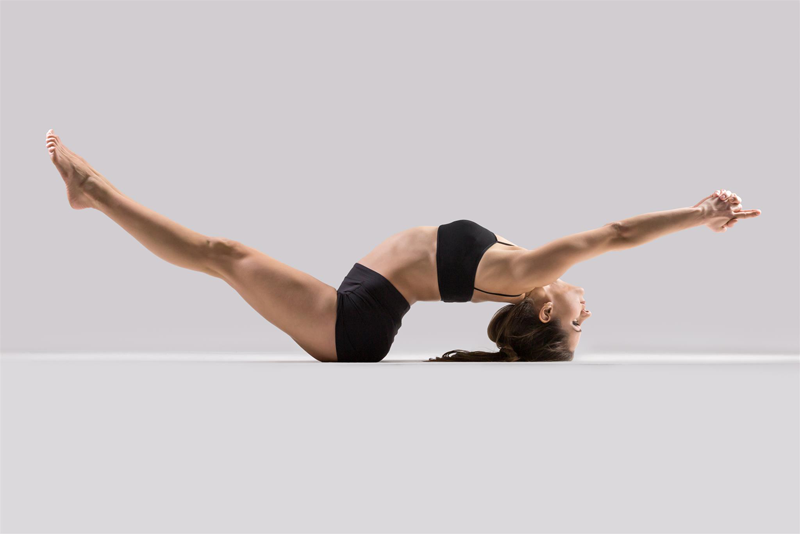
The Health Benefits of Yoga
April 17, 2018
Yoga to Improve Blood Circulation
April 27, 2018What is Hot Yoga?

Hot Yoga is best explained as a yoga style practiced in a heated studio. While most hot yoga classes are performed in temperatures of 100 degrees plus, the term refers to any yoga practice that uses heat. Many yogis enjoy practicing in a hot and humid studio to replicate the Indian climate, which is where yoga first originated. Others simply use hot yoga for its wide array of health benefits. In this article, we explore hot yoga in more detail. If you’re interested in practicing the style, it’s important to wear a lightweight yoga top to allow your body to oxygenate.
History and Origins
Today, there are various different styles of hot yoga. However, the trend was started by a style called Bikram. Founded by yoga guru Bikram Choudhury, the style first became popular in the 1960s. After seeing the success of Bikram, many other yoga styles began to incorporate heat into their practice. Below, we discuss the four main types of hot yoga.
Types of Hot Yoga
Bikram yoga
As mentioned above, Bikram Yoga was the first hot yoga style. To this day, the style is regarded the most popular of all the hot yoga types. The style is practiced in a studio heated to 100 degrees and comprises of 26 different asanas. The postures are designed to be practiced in a set order for the duration of a 90-minute session. When performed correctly, the sequence is thought to target every part of the body. Bikram is also designed to flow fresh, oxygenated blood around the body by inducing a tourniquet effect. This is created by stretching, balancing, and creating pressure in unison. Certain asanas cause the blood supply to be temporarily restricted, allowing pressure to build up in the veins and arteries; when the pos-ture is released, fresh blood rushes through the body.
Yin Yoga
Yin Yoga is a slow-paced style of yoga that focusses on physical asanas. In Yin Yoga, the postures are held for a longer duration than they are in other styles; beginners are advised to hold each position for around two minutes, while more advanced yogis are encouraged to hold the stretch for five minutes. When prac-ticed correctly, Yin Yoga brings with it a host of great health benefits. Specifically, the practice works with the yin tissues in the body. These are more commonly referred to as the connective tissues. This type of muscle responds best to slow movement, which is why Yin Yoga encourages practitioners to hold the asanas for longer. Gently stretching the tissue for an extended period of time will start to build flexibility and strength.
Forrest yoga
Forrest Yoga is a fairly modern technique. Based on the Hatha practice, the style was developed by Ana T. Forrest. Much like Yin Yoga, Forrest Yoga holds the postures for a longer duration of time. In a standard sequence, students will repeat the same 20 asanas for a 45-minute session. When performed correctly, the asanas provide an equal stretch on each side of the body. Holding the postures for longer than average helps to form a connection between your emotional and physical body. When performing the asana, yogis have time to reflect upon their inner feelings.
Power yoga
Power Yoga is classed as a Vinyasa style. Focussing on dynamic movement, this style of hot yoga is ideal for those looking to improve their fitness level. When performed correctly, each posture should flow into the next. Often, the sequence is performed to music to help maintain a rhythm. Power Yoga also uses breathing techniques to improve the flow. When breathing is synchronized with movement, students will achieve a higher level of flow.

Benefits of Hot Yoga
Like any style of yoga, hot yoga brings with it a variety of great benefits. Performing in a heated studio allows the muscles to stretch further without injury. This allows practitioners to reap the full benefits of each asana without causing muscle damage. The heat also increases your metabolism and pulse rate; this helps your body to burn more calories and increases blood flow to the body. Most hot yoga styles are designed to induce a sweat. This encourages the body to release built-up toxins, helping practitioners to leave each session feel healthy and revitalized.
Another benefit of Hot Yoga is the improved level of focus it can provide. Enduring a 90-minute session in a hot, humid studio teaches students to develop a ‘mind over matter’ outlook. Whilst this helps them to better their practice, the technique can also be used in day-to-day life. Once you can use this technique, there is little you can’t accomplish. In turn, this often provides practitioners with a higher level of self-confidence.
Tips for Practicing
Though Hot Yoga can provide numerous health benefits, there are certain precautions that need to be taken to stay safe. Below, we discuss these in more detail.
Stay Hydrated
One of the most important things to remember when using Hot Yoga is to stay hydrated. Though sweating profusely can leave you feeling healthier, it can also lead to dehydration if you haven’t had enough water before the session. In addition to drinking before each class, it is recommended to stay topped up during and after your practice, too. In general, everyone is encouraged to drink eight glasses of water per day. When practicing high-intensity exercise, this amount should be increased by at least two glasses. To feel even better, try to drink a natural sports drink before class. This will help to replenish the sodium you lose through sweating.
The Rules For Eating Before Hot Yoga
It is also important to think about what you’re eating before a hot yoga class. Whilst eating too much can leave you feeling bloated, eating too little can leave you feeling light-headed and nauseous. For best re-sults, we recommend avoiding heavy foods before class and fuelling your body with light snacks, instead. Fruit with a high water content can be a good choice, as this will help to keep you hydrated and energized throughout the session.
Listen to Your Body
The final tip we have is to listen to your body. Even if all the right precautions are taken, you may need to take a time-out during a class. If you begin to feel light-headed, nauseous, or unwell in any way, don’t be afraid to take a few minutes outside. If you don’t start to feel better, it may be worth giving the rest of the class a miss.
In Summary
Whether you’re hoping to detoxify your body, or you’re more interested in burning extra calories, hot yoga can help you to achieve your goal. When attending a hot class, always remember to wear lightweight yoga clothes to prevent your body from overheating.

